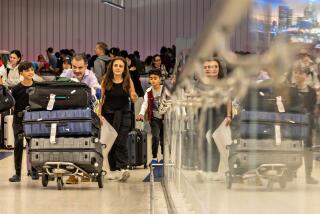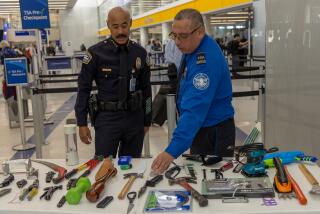Dissatisfaction with airport screening procedures is ebbing

- Share via
Americans don’t love the TSA, but they are learning to tolerate it.
In the last few years, the Transportation Security Administration has removed the full-body scanners that create nude-like images of passengers and restricted pat-down searches of children and the elderly, among other changes.
A new survey suggests that such efforts have made TSA screening less offensive to travelers.
Among more than 2,700 adults questioned in a recent survey, 64.2% said they were satisfied with airport screening procedures, with an additional 23.3% saying they were neutral on it. By comparison, the same survey last year found that 62.2% were satisfied and 19.8% were neutral.
Meanwhile, the share of travelers who described themselves as “unsatisfied” about airport screening dropped to 12.5% from 18% last year, according to the online survey by Travel Leaders Group, a Minnesota travel agency company.
TSA officials say the agency has worked hard to ease the screening process for frequent travelers to focus more attention on high-risk fliers.
“Collectively, these efforts are part of a systemwide shift away from the one-size-fits-all security model following the 9/11 attacks,” TSA spokesman Ross Feinstein said.
Longtime critics of the TSA acknowledged that the agency has eliminated some procedures that annoyed travelers — such as the “nude scanner.” But most of those changes came after an outcry from travelers, said Paul Hudson, president of FlyersRights.org, a nonprofit passenger rights group.
“I would say there have been some improvements, but in many cases it has come after some kicking and screaming,” he said of the TSA.
Avoiding loyalty reward loopholes
If you are saving loyalty reward points for your dream vacation, be wary of loopholes that can kill nearly one-third of your points.
The 10 largest credit card issuers offer up about $48 billion in loyalty rewards each year, but one-third of those rewards are never redeemed because of loopholes and limitations, according to a new study by CardHub, a credit card review site.
A requirement that you meet a minimum threshold before you can redeem your reward points was the most common limitation found in the study, followed by rewards that expire after a missed payment.
Capital One cards have the fewest reward limitations, the report said, while the Discover It card has the most.
Odysseas Papadimitriou, chief executive of CardHub, offered this tip: Get a card that offers real cash rewards, not fictitious currency like “dividend dollars.” Reward programs can reduce the value of fictitious money, he said, “but they can’t change the value of cash.”
Why Bloody Marys are popular on flights
Bloody Marys and other tomato-based drinks may be popular on airline flights because the flavor of umami is not diminished by loud noise and low cabin air pressure.
That theory was raised by Barry Smith, founder of the Centre for the Study of the Senses at the University of London, and his colleagues in a recent scientific article that appears in the journal Flavour.
Umami is the flavor mostly associated with meats, vegetables and cheese. To prove the theory, Smith and his colleagues suggest a scientific study that feeds umami-rich foods to test subjects under various conditions, including while in flight, wearing noise-canceling headphones.
“Perhaps all those travelers who order a Bloody Mary after the seat belt sign has been turned off have figured out intuitively what scientists are only now slowly coming to recognize empirically,” the article says.
More to Read
Inside the business of entertainment
The Wide Shot brings you news, analysis and insights on everything from streaming wars to production — and what it all means for the future.
You may occasionally receive promotional content from the Los Angeles Times.










